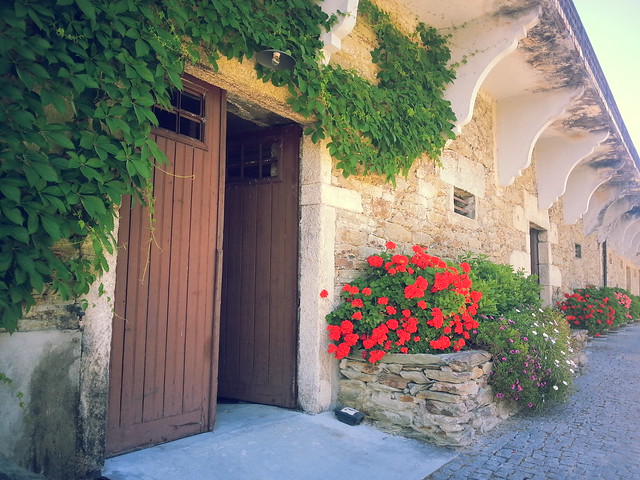Flyday Fridays (The Wine Series): Port Wine
Happy Friday, luvs!
In line with the holiday tradition of stuffing ourselves to death and having an excuse to get drunk tipsy, I´m making a series of posts about wines this month. I´ve been fortunate enough to live in one of the best wine-making countries of the world and with Portugal as a neighbor(aside from France on the other side), I got to taste the best wines from where they are actually produced and bottled.
In the early spring of this year, the hubz surprised me with an anniversary trip to the Duoro region of Portugal. That´s the reason for the denim shirt dress in the photo. ;) This region is the port wine making region of Portugal and is very famous. As we rode by on the sloping hills and mountains of the valley,we saw this small port winery called Quinta Do Tedo nestled in-between River Duoro and River Tedo on the other side.


Here´s our guide during our port wine tasting, port comes in a variety of colors depending on the variety and color of the grapes used and the ageing process:

Port wine production starts with the treading the grapes on this part called lagares the natural way( foot) or sometimes through the mechanical way, a mechanical treader which I forgot to photograph, hahaha! The crushed grapes then undergoes a fermentation process until about half( or depending on the standard of the winery) of the grape sugar turns into alcohol, treadng is stopped and..

the clear fermented wine is later stored on these vats where temperature and sugar level is monitored among others. Brandy is added to raise the alcohol content and to stop the yeasts fermenting further the remaining sugar thus leaving out that sweetness which you´ll taste in the port wine later.

The vats and the oak barrels for ageing the port wine are stored below here:


These barrels are huge, and are used for ruby port:
Our guide also showed us these stacked vintage bottled port wines separated by the year they are produced:

Since we´ve already tasted white and tawny port when we visited Porto, we tried the reds this time: rosé( which is fairly new in the port wine production), ruby and vintage:

Here´s what we bought , a rosé port which is a fairly new type of port wine. ;)
Finally, here´s a spring photo of the valley and my denim shirt dress. The hubz included this dress in his spring cleaning while I was on vacation in my tropical lalaland and so only the photos remain. Huhuhu!
Port/porto is a sweet fortified wine, meaning, sweet but high in alcohol content. It´s best paired with appetizers or to accompany your dessert. If you want to visit the Qinta do Tedo winery, I highly recommend it because it´s like taking a private tour and the view around it is impressive. It literally takes your breath away! :)
I hope you enjoyed reading this post. More to come! ;)
xoxo,
Che
In line with the holiday tradition of
In the early spring of this year, the hubz surprised me with an anniversary trip to the Duoro region of Portugal. That´s the reason for the denim shirt dress in the photo. ;) This region is the port wine making region of Portugal and is very famous. As we rode by on the sloping hills and mountains of the valley,we saw this small port winery called Quinta Do Tedo nestled in-between River Duoro and River Tedo on the other side.


Here´s our guide during our port wine tasting, port comes in a variety of colors depending on the variety and color of the grapes used and the ageing process:

Port wine production starts with the treading the grapes on this part called lagares the natural way( foot) or sometimes through the mechanical way, a mechanical treader which I forgot to photograph, hahaha! The crushed grapes then undergoes a fermentation process until about half( or depending on the standard of the winery) of the grape sugar turns into alcohol, treadng is stopped and..

the clear fermented wine is later stored on these vats where temperature and sugar level is monitored among others. Brandy is added to raise the alcohol content and to stop the yeasts fermenting further the remaining sugar thus leaving out that sweetness which you´ll taste in the port wine later.

The vats and the oak barrels for ageing the port wine are stored below here:


These barrels are huge, and are used for ruby port:
while these normal sized oak barrels are used for ageing tawny port:
Our guide also showed us these stacked vintage bottled port wines separated by the year they are produced:

Since we´ve already tasted white and tawny port when we visited Porto, we tried the reds this time: rosé( which is fairly new in the port wine production), ruby and vintage:

Here´s what we bought , a rosé port which is a fairly new type of port wine. ;)
Finally, here´s a spring photo of the valley and my denim shirt dress. The hubz included this dress in his spring cleaning while I was on vacation in my tropical lalaland and so only the photos remain. Huhuhu!
Port/porto is a sweet fortified wine, meaning, sweet but high in alcohol content. It´s best paired with appetizers or to accompany your dessert. If you want to visit the Qinta do Tedo winery, I highly recommend it because it´s like taking a private tour and the view around it is impressive. It literally takes your breath away! :)
I hope you enjoyed reading this post. More to come! ;)
xoxo,
Che





Comments
♥
http://anna-and-klaudia.blogspot.com/